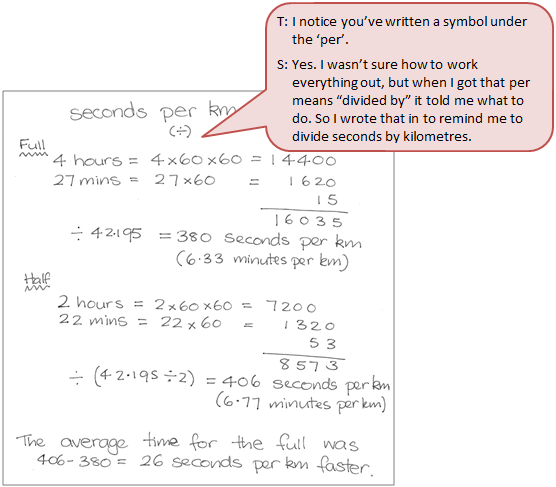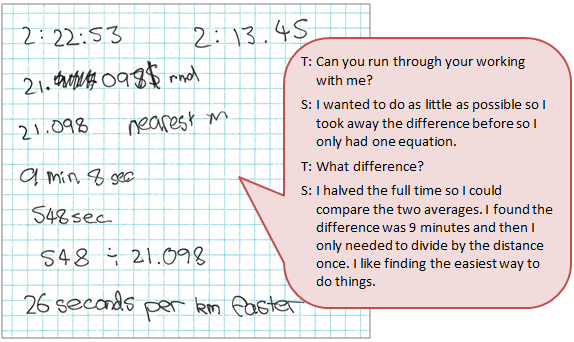The purpose of this activity is to engage students in solving a problem involving fractions (time in hours, minutes and seconds) and decimals (distance in km) to find a rate.
This activity assumes the students have experience in the following areas:
- Converting among hours, minutes, and seconds.
- Finding a rate that connects two variables.
- Subtracting decimals.
The problem is sufficiently open ended to allow the students freedom of choice in their approach. It may be scaffolded with guidance that leads to a solution, and/or the students might be given the opportunity to solve the problem independently.
The example responses at the end of the resource give an indication of the kind of response to expect from students who approach the problem in particular ways.

In the 2014 Auckland marathon, the average time was 4:27:15 for the full and 2:22:53 for the half.
A full marathon is 42.195 km in length. How much faster (in minutes or seconds per km) was the average full marathon pace than the half?
The following prompts illustrate how this activity can be structured around the phases of the Mathematics Investigation Cycle.
Make sense
Introduce the problem. Allow students time to read it and discuss in pairs or small groups.
- Do I understand the situation and the words? (Students may need support to understand the meaning of marathon and half marathon if they have no experience of these events.)
- What are the important numbers and what do they mean? (4:27:15 is interpreted as 4 hours, 27 minutes, and 15 seconds. 42.195 kilometres is interpreted as 42 kilometres and 195 metres.)
- Where else in my life/the world can I see this happen? (Speed of cars may be more familiar to students.)
- What will my solution look like? (The solution will be a difference in rates between the marathon and half-marathon averages. It will be expressed as minutes per kilometre or kilometres per minute, accompanied by clear working and justification.
Plan approach
Discuss ideas about how to solve the problem. Emphasise that, in the planning phase, you want students to say how they would solve the problem, not to actually solve it.
- What are the maths skills I need to work this out? (Strategies with rates involve multiplicative thinking.)
- What might the solution be? What is a reasonable estimate? What is not reasonable?
- How could I show this problem using numbers, pictures, graphs, tables, or materials?
- What strategies can I use to get started? (Ratio tables are useful in organising the conversion among quantities.)
- What tools (digital or physical) could help my investigation? (Calculators or spreadsheets will ease the burden on working memory and provide the calculations required.
Take action
Allow students time to work through their strategy and find a solution to the problem.
- Have I shown my workings in a systematic way?
- Have I included all the information?
- Are all my calculations carefully checked and match the conditions of the problem?
- Does my answer seem correct? Is it close to my estimation?
- How could I make sure that I haven’t missed anything?
- Have I recorded my ideas in a way that helps me to see patterns?
- Are there any patterns?
- How might I describe the pattern?
- Is there another possible answer or way to solve it? Which strategy will be most efficient?
Convince yourself and others
Allow students time to check their answers and then either have them pair share with other groups or ask for volunteers to share their solution with the class.
- What is the solution? Does it meet the requirements for the solution?
- Is my working clear for someone else to follow?
- Could I have solved the problem in a more efficient way?
- Which ideas would convince others that my findings answer the investigation question?
- Would my strategy work in a different situation? What kinds of situations would it work for?
- Which ideas or tools worked well in my investigation?
- What could I try differently next time?
Examples of work
Work sample 1
The student calculates, with guidance, values in standard form, giving an answer to an appropriate degree of accuracy.
Click on the image to enlarge it. Click again to close.
Work sample 2
The student converts the rates for marathon and half to a common distance, finds the time difference, and converts to a unit rate per kilometre.

